Summer will be shortly upon us here in this half of the world! And along with summer comes a fantastic opportunity to introduce kids to embroidery, giving them a gift that will last them all their lives – an appreciation for making something with their own two hands.
Usually around this time of year, I get a lot of requests for recommendations for children’s embroidery projects or books that can help introduce a child to embroidery.
Well, if you have children in your life, and you’re eager to spread the joy of needlework to them, there’s a fantastic new book out aimed just at kids, called The Amazing Stitching Handbook for Kids.
After seeing mediocre needlework books and kits and whatnot aimed at children come and go over the years, I’m really happy to see this particular book. It’s a terrific information, reference, instructional, and project book.
I like it a lot! I like it so much that I’ve purchased copies of it to use for summer birthdays (and other occasions) and bundled it with basic supplies. It’s an ideal book for helping a child to start stitching!
Let’s look at it in detail…
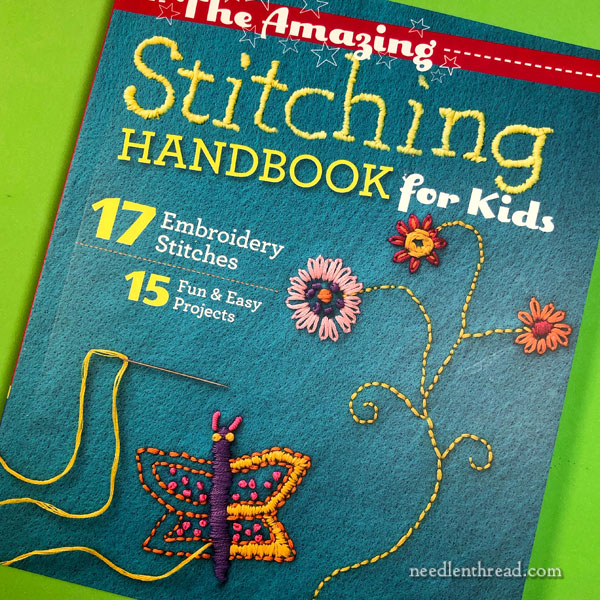
The Amazing Stitching Handbook for Kids by Kristin Nicholas is pretty much what the title promises it to be – a really good handbook directed at teaching children the basics of stitching.
The funny thing is, the book is full of great beginner information and techniques for needlework, so much so that I’d be tempted to say that it’s not just for kids. The projects are kid-oriented, sure, but all the foundational information that is useful for the beginning embroiderer is in the book – even more so than you’ll find in many adult beginner embroidery books!

After the introduction, the book begins with a section on materials. All the content is presented in a kid-friendly way, with clear images of what’s what.
I like this materials section! It covers types of fabric, threads, and tools, touching on all the basics, but also going into a little more detail than you’d expect in a children’s book. The detail, however, is good and it’s well-presented. It doesn’t “overwhelm.” Instead, it gives kids somewhere to go when they want to expand their knowledge, find different materials, or do different things with needlework.

When talking about fabrics, she explains things like fabric grain, and how to cut different types of fabric to use them for embroidery.
Good stuff to know – and all presented in a very accessible way for kids.

I love the fact that she does not assume that kids must start out with thick and chunky thread, like heavy perle cottons. They can stitch with perle cotton. She talks about perle cotton and lists it in the supplies, and some of the projects can easily be done with perle cotton.
But she shows kids how to strip regular floss for more delicate stitching and how to split up Persian wool, too.

I also love the fact that she covers needles! She doesn’t assume that, just because it’s kids, they’ll only be using blunt needles with huge eyes.
Instead, she gives them the right tools for the job and shows them how to use the tools. That’s what a good teacher does.

The book starts out with gridded stitches, where there are instructions and projects for needlepoint and for cross stitch.
Keep in mind that the book has to cover a lot of information to give children a taste of these different types of needlework, so it doesn’t go into a multitude of needlepoint stitches, nor does it cover counted cross stitch.
Instead, it gives the basics – tent stitch and cross stitch – for working on a gridded foundation.
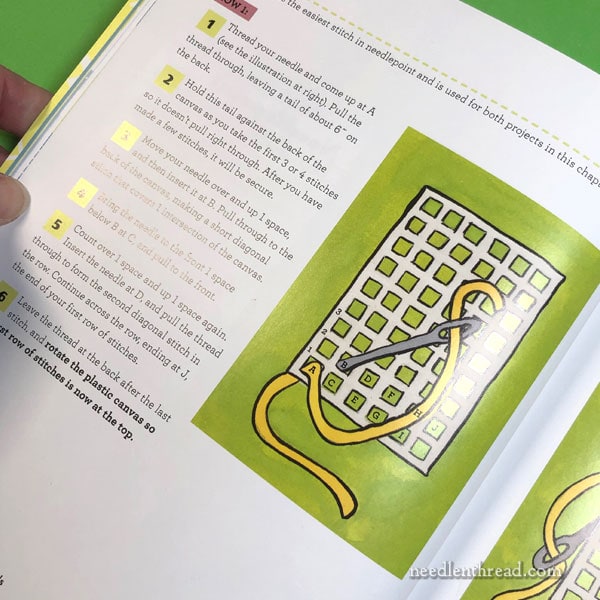
There are clear diagrams and drawings that show the child how to manage the stitches involved in the technique and how to do things like start and finish threads.
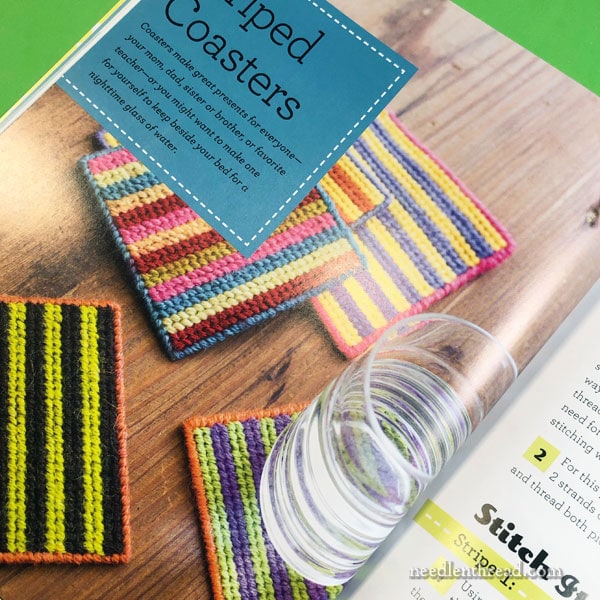
The projects in this section include little finished things like these colorful striped coasters made from plastic canvas, worked in tent stitch.
Now, you might be tempted to think, “Oh, tent stitch is such a boring stitch. Why not teach them some more exciting needlepoint stitches?”
The fact is, tent stitch is the perfect introduction to needlepoint for kids, because it is repetitive. Children like the security of repetition when they are learning something. It gives them confidence. The key to making something like this exciting is color choice on a small enough item so that the finish is quick and successful.
Once children make something like these coasters, give them the opportunity to actually use them. This will make their needlework not only exciting (and something to be proud of), but it will also make it relevant.
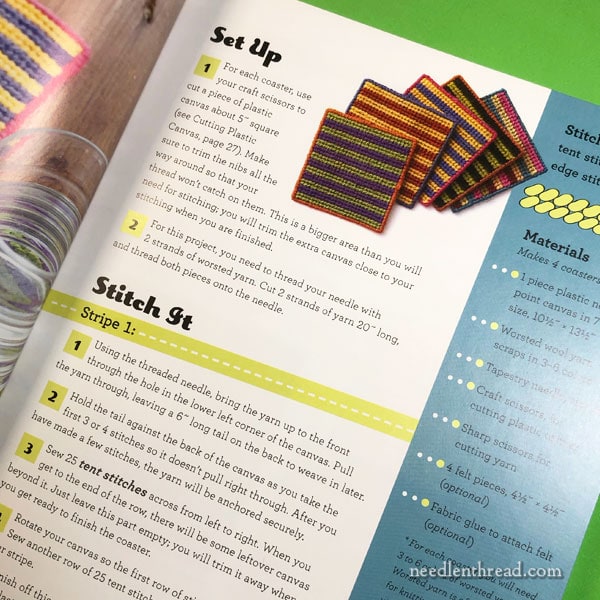
The projects in the book are presented with a materials list, how to start (the set-up), how to stitch the project, and…

…how to do the finish work.
This is such an important step! The finishing instructions help children see that needlework is beautiful and useful. Finish work also helps them develop further ideas, too, about what they can make and how they can make it.
There are a few other projects in this section, too, before moving on to surface or free-form embroidery.

The author teaches children two ways of stitching – stabbing and sewing – right from the beginning. This is a good approach, because it will help them later to understand stitch diagrams, which are often drawn in the “sewing” method, even when “stabbing” is a better choice for some types of embroidery.
The idea here, though, is really to do whichever is more comfortable.
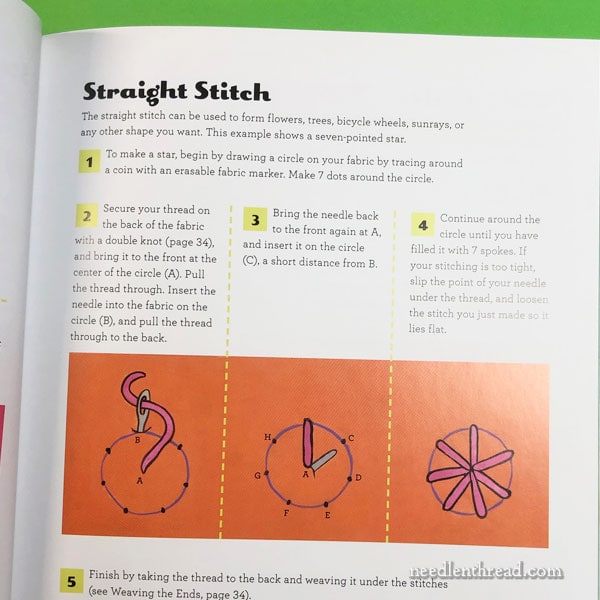
The embroidery stitches in this section are all presented in clearly drawn diagrams.
Be aware that the stem stitch instructions are a little vague, so you might have to provide a little extra instruction there. That’s the only negative point I found in all the instructional content in the book!

Some of the projects for the free form embroidery section include a little needle book…

…a pincushion…

…embellishing clothing (everything old is new again, right?)…

…a fabric and embroidery wall picture, book marks, a stuffed owl, name tags and luggage tags, and other fun little projects.

In the section on Fancy Stitches, the kids learn French knots and bullions, spider web stitches, and other fun stitches for adding variety to their projects.

There are several projects in this section, too, among which are some really cute handmade cards…
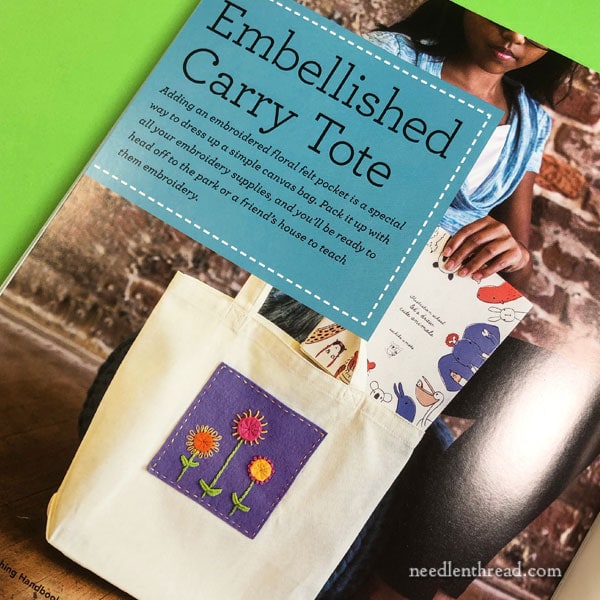
…a really cute embellished tote bag…

…and lots of colorful and quick embroidered patches.
In the back of the book, you’ll find some resources for supplies. You’ll also find three pages of small embroidery designs that can be traced and used for embellishments for the different projects presented in the book.
In a Nutshell
This is a fantastic book for kids to learn embroidery! Not only will they learn good foundational habits, but they will have fun learning, thanks to a plethora of relatively quick projects that range from very simple (for quick success) to a little more complex (for those who want a challenge).
The book is geared towards children who can read, but if you’re working with younger children who haven’t quite mastered the written word, you can guide them through the projects easily enough, and the diagrams and drawings make it easy to understand how the stitches work.
The book is thorough, affordable, and fun!
Where to Find It
You can find The Amazing Stitching Handbook for Kids available through Amazon – you’ll find it listed in the top spot on my Amazon Recommendations page here.
And here’s a direct link to the book on Amazon.
Worldwide, with free shipping, you can find it available here on Book Depository.
This article includes affiliate links to book sources. Needle ‘n Thread receives a small commission for any purchases made through those links, at no added cost to you. Thanks for helping Needle ‘n Thread with your purchases through my affiliate links!







Thanks! I just ordered 4 copies through your link – a great gift idea!!!
Dear Mary ~ this sounds an absolutely wonderful beginner book for all ages. I was particularly tickled by the cross-stitch on the gingham. When my girls were little, they had matching gingham (orange) square yoke tops to wear with jeans. The yokes I cross-stitched in brown before the assembly. They looked so pretty in them. Thanks for bringing that memory back.
Curious to know, you already have a great summer program for kids, will this book change in any way how you put the curriculum together. I’m sure you’ll post about it and look forward to reading it (them).
Best wishes and happy stitching, Brenda.
I wish I had this back in the day! I started with Holly Hobby and “progressed” to bloody stumps of fingers, only to realise, finally, there was a better way! What a great book. Thanks for finding it & sharing. 🙂
It was interesting on your take on the type of thread and needle for a child to use in their first attempt at embroidery! I am right with you on that. I did my first embroidery over 50 years ago probably at age 10-11. I used 6-strand cotton and separated the threads however I felt like (no help from mom there or any book) and I used a normal sharp needle. All I had was a pair of pillowcases, an embroidery iron-on transfer, a couple of skeins of floss I only used the same 3 colors through two sets of pillowcases, and a needle. I don’t think I ever even knowingly saw any Perle cotton until I was in my 40’s or 50’s. I won’t say how long I used a sharp needle for doing counted cross stitch!
Over the years things have changed so much. I saw an internet report yesterday where they were talking of a girl leaving her grandmother to go back to the car to get something that had been forgotten. The emphasis in the whole story was that she was a little (agewise) girl. At 12 in the summer I had a job babysitting two kids all day while the mom worked next door mind you, but I also babysat past midnight for others and no one thought a thing about it. I don’t know what happened in the last 50 years that kids are being treated so much like little ones and yet at the same time are encouraged to ‘date’, wear makeup, and do all sorts of adult activities. I would have been very confused. I am so glad that as a teacher you give children the credit of having the ability to learn and grow and don’t need to be treated as babies with a pair of scissors! I think they will grow up loving the craft so much more for having been started off correctly.